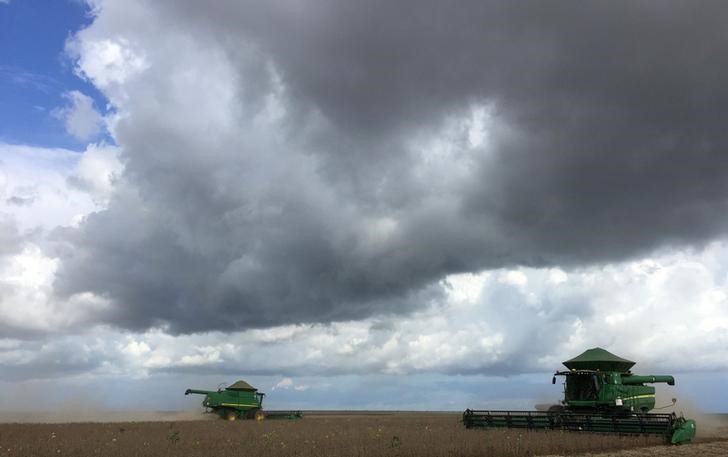(Bloomberg) -- Terms of Trade is a daily newsletter that untangles a world embroiled in trade wars. Sign up here.
In the grips of the demand-killing U.S.-China trade war, American farmers took an unprecedented gamble last year and stored huge amounts of soybeans after the harvest, hoping they’d eventually find better prices.
The bet paid off.
Matt Gast stashed three-quarters of his crop -- way more than ever before. Most years, he stored maybe 15%, but selling last season, would’ve meant accepting loss-making prices while the biggest customer was out of the market. So he hoarded those beans in silos and bins on his North Dakota farm.
A short rally earlier this year meant he was able to lock in prices at about $9.50 a bushel, roughly 70 cents higher than he would have gotten at harvest time -- certainly not a killing, but better than rock bottom. The beans are coming out of storage this month and finally moving for delivery.
“It was definitely worth keeping them,” Gast said.
Long-Term Shift
For decades, American farmers were in the habit of selling almost all their soy as soon as it came off fields. China, the world’s top soy importer, had such a voracious appetite that there was plenty of demand for the crop. That all changed with the trade war, and it could end up being a long-term shift.
The storage strategy is one of last resort for cash-strapped farmers battling low prices amid dismal demand. If the market stays similar to how it is now, soy will go into storage again this year and corn will get sold, farmer Jeff Jorgenson predicts.
“It’s backwards -- it absolutely is,” said Jorgenson, who’s also a director of the Iowa Soybean Association.
Even if Donald Trump and Xi Jinping strike a deal tomorrow, a year of Chinese tariffs will have long-running effects on global soybean flows. Brazil has stepped up to meet demand and tightened its grip on the title of word’s top exporter. Farmers in Argentina are producing more, and plantings are even going up in China.
U.S.-China Spat Risks Permanently Altering Trade, Cargill Warns
The hoarding puts American producers in the company of growers from places like Argentina, where soybeans are often stored as a sort-of insurance policy against currency swings, government intervention and general market volatility.
U.S. soybean stockpiles as of June 1 totaled a record 1.79 billion bushels, up 47% from 2018, the Department of Agriculture said June 28. That number jumped largely because supplies stored on farms almost doubled. It could start to decline as beans now move out of silos.
Jorgenson’s sales nearly halted around harvest when cash prices plunged as low as $7.25 at the processing plant in western Iowa where he hauls most of his supplies. He started boosting sales early in 2019 as prices recovered and was able to sell for around $8.40. He’s still got about 10% of the crop, and like many farmers, he needs to finish selling to cover loans taken out in 2018.
Coupled with big yields and government aid, “I had price satisfaction,” he said. “But it wasn’t a home-run year by any stretch.”
The rallies have been short-lived for the most part, so the hoarding gamble only paid off for farmers who could be nimble.
When Trump met Xi in December, the market got a boost on hopes of a deal. As the optimism fizzled, futures in Chicago tumbled back to a decade low by mid-May. Recently, prices have been on the upswing again as incessant Midwest rains raised concerns over this year’s plantings.
“It’s great for those who had that opportunity” to sell on rallies, said Sam Funk, director of agriculture analytics and research for the Iowa Farm Bureau. “For the entire system to be able to find those profitable marketing opportunities, it’s going to take a reopening of those markets.”
Nasty Smells
The spring deluge that helped send prices higher also created problems for farmers whose storage facilities were vulnerable to flooding. Even the slightest increase in moisture can result in mold and nasty smells that lower the crop grade or make the soy unmarketable.
“We get nervous about holding soybeans. They can go bad in bins pretty quick,” said Sarah Lovas, a farmer in Hillsboro, North Dakota.
This year’s crop is now underway. Production is forecast 15% lower compared with last year’s all-time high, the USDA said Thursday. Even with the decline, it could be one of the biggest crops on record. Farmers need to make space in silos now, so they can store again.
“This year’s crop we have zero percent sold,” Gast of North Dakota said. “We will take our chances.”
